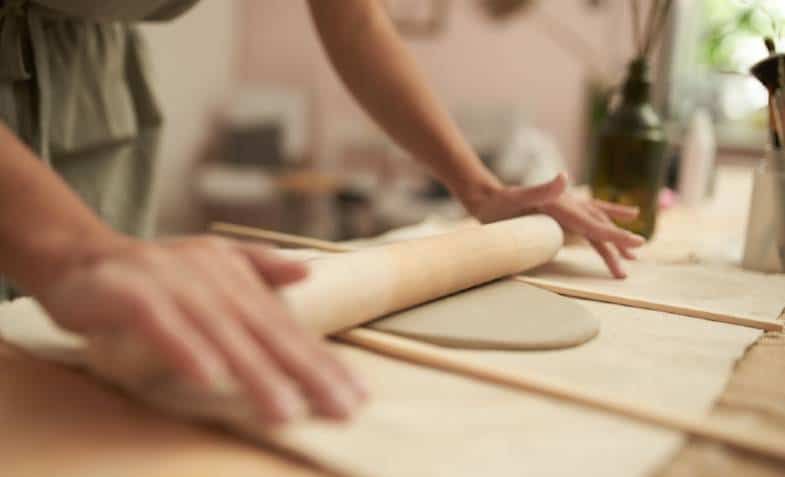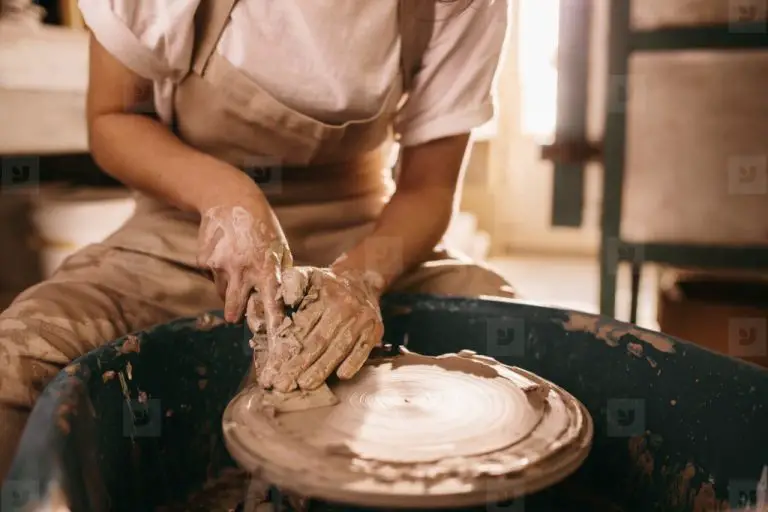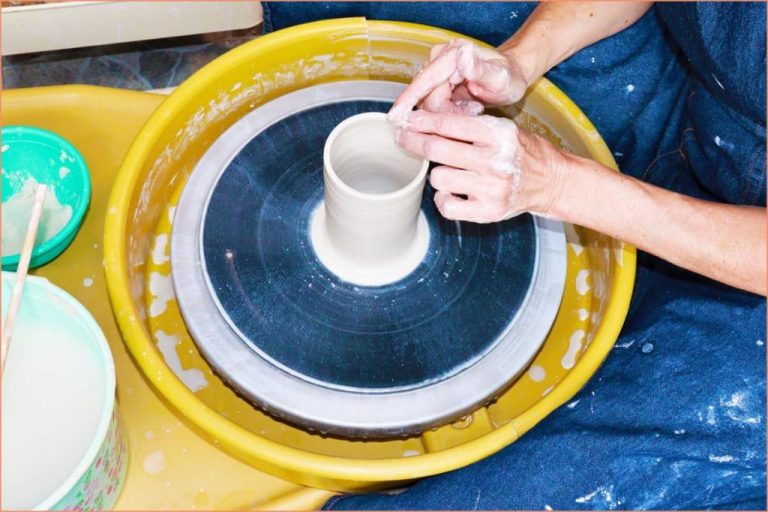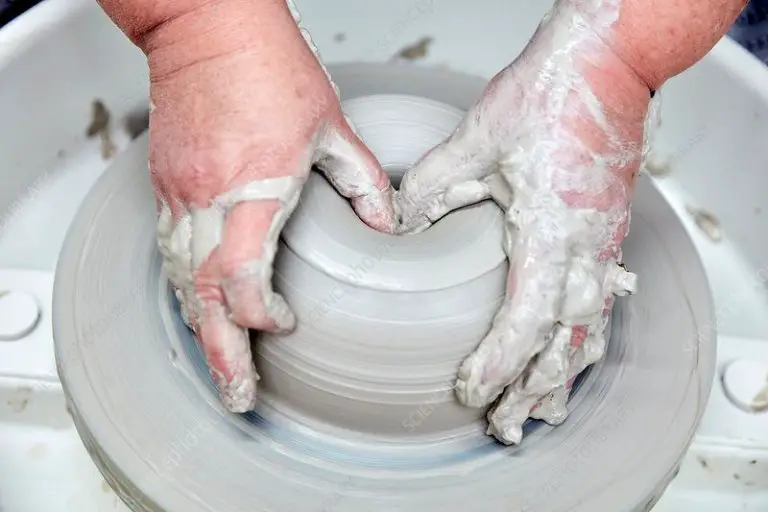What Does A Slab Roller Do?
What is a Slab Roller?
A slab roller is a machine used in pottery and ceramics to roll out slabs of clay 1. It consists of a large flat table with a heavy rolling pin mounted above it. The rolling pin is mechanically powered and rolls back and forth over the clay, compressing it into a flat even sheet or “slab” 2.
Slab rollers allow potters to quickly and evenly roll out large slabs of clay in a variety of thicknesses. This saves time and effort compared to rolling out slabs by hand using a rolling pin. The automated roller applies even pressure across the entire slab, creating a flat surface without lumps or uneven spots.
Slabs produced on a slab roller have many uses in pottery. They can be cut into shapes, joined together and built into hand-formed pottery pieces. Slabs also allow potters to create consistent flat surfaces for techniques like relief sculpture, carving, decorative effects, attachments and laminations.
History of Slab Rollers
Slab rollers have been around for thousands of years, with early versions used by ancient civilizations for working with clay. Ceramic slabs, also called ceramic tiles, have existed for over 4,000 years according to this source. Potters and ceramic artists have long needed tools for rolling out slabs of clay to even thicknesses for handbuilding and tilemaking.
The earliest slab rollers were simple tools like rolling pins made of wood or stone. More advanced mechanical slab rollers started emerging in the early 20th century. In the 1920s, the first powered motorized slab rollers were invented by companies like Soldner. This allowed larger and thicker slabs to be produced with more consistency. Key innovations that were introduced over the years include adjustable thickness settings, longer rollers, and heavier duty motors and frames. Modern slab rollers now allow for precise control over slab thickness and large rolling capacity.
How Slab Rollers Work
Slab rollers work by passing clay through two parallel rollers that apply pressure to flatten and compress the clay into a uniform slab or sheet. The clay is fed into an opening between the rollers, usually with a hand crank or motorized system to turn the rollers. As the rollers rotate, the clay is gradually compressed and thinned out while being pushed through to the other side, producing an even sheet of clay of the desired thickness.
Most slab rollers have adjustable roller spacing to control the thickness of the slab produced. The closer the rollers are set, the thinner the resulting clay sheet will be. The rollers themselves are usually made of stainless steel or aluminum and may have a non-stick coating to prevent clay from sticking. Some advanced models even allow heating elements in the rollers to help condition the clay as it passes through.
To ensure an even slab thickness, slab rollers require the clay to be fed through at a constant rate. Any lumps or air bubbles in the original clay block will be minimized as it passes between the rollers. The compression also aligns the clay particles to give greater strength to the finished slab. The rollers essentially mimic the process of rolling out slabs by hand but in a much more efficient and consistent manner.
Uses and Applications
Slab rollers have a variety of uses in working with sheet materials, the most common being clay and ceramics. They allow potters and ceramic artists to efficiently roll out large, flat, and uniform slabs of clay to use in handbuilding projects. This saves significant time compared to rolling out clay slabs by hand.
Some common uses of slab rollers in pottery and ceramics include:
- Rolling slabs for handbuilding boxes, vases, bowls, and other vessels
- Creating even rolling pins for making patterned slabs
- Rolling flat slabs for tiles or applying texture
- Making large flat slabs for throw drapes or faceted forms
- Achieving consistent thicknesses across a clay slab

Beyond clay and ceramics, slab rollers can also be used for rolling out sheets of other materials. Glass artists may use them for fusing or slumping projects with sheet glass. Metal artists can roll out sheets of copper, brass, or silver for forming metal vessels. Some slab rollers even accommodate wood veneers, fondant, polymer clay, and other materials in thin sheet form.
Types of Slab Rollers
There are several different types of slab rollers available for working with clay. The main categories are:
Manual Slab Rollers
Manual slab rollers require the user to apply physical force to roll out the clay slab. These tend to be more affordable options but require more physical effort from the artist. Manual slab rollers may have a single rolling pin design or two rolling pins mounted in a frame (Bailey Pottery).
Powered Slab Rollers
Powered slab rollers use an electric motor to drive the rolling pins, eliminating the need for the user to manually roll the clay. These models allow the artist to more easily achieve consistent thickness and work with larger quantities of clay. Powered slab rollers range from more compact tabletop models to heavy-duty free-standing machines (Sheffield Pottery).
Electronic Slab Rollers
Electronic slab rollers add digital controls and features like adjustable speed, digital thickness display, and memory presets. This allows for precision rolling at exact thicknesses. High-end electronic slab rollers may even include features like hydraulic operation and digital pressure sensing (The Ceramic Shop).
Slab Roller Features
Slab rollers have a variety of features that are important when selecting the right model. Key features to consider include:
Size: Slab rollers come in different widths, typically ranging from 12 inches to 24 inches or more. Wider rollers can accommodate larger slabs. Length also varies. Consider the size of clay slabs you need to produce when choosing a size. Some models have removable side panels to convert to a narrower roller width (Source: https://www.baileypottery.com/hand-building-clay-equipment/slab-rollers-by-type/all-slab-rollers.html).
Rollers: Most slab rollers have two rollers that compress the clay into a slab. Rollers may be made of various materials like steel or aluminum. Some models have a third roller for extra compression. The texture of the rollers impacts the slab’s surface (Source: https://thepotterywheel.com/what-is-a-slab-roller/).
Speed Control: Variable speed control allows adjusting the roller speed to suit the clay consistency and desired thickness. Slow speeds work best for thicker slabs (Source: https://www.baileypottery.com/hand-building-clay-equipment/slab-rollers-by-type/all-slab-rollers.html).
Safety Features: Some slab rollers have safety features like non-slip feet, emergency stop buttons, and guards to protect hands. These help prevent accidents when operating the roller (Source: https://thepotterywheel.com/what-is-a-slab-roller/).
Buying Considerations
There are several key factors to consider when choosing a slab roller:
Cost – Slab rollers range greatly in price from under $100 for basic manual models to over $2,000 for heavy-duty electric rollers. Determine your budget and needs.
Size – Consider the size of slabs you need to produce. Mini tabletop rollers produce small slabs under 12 inches wide, while larger studio models can handle slabs over 20 inches wide.
Materials – Rollers are available in a range of materials like wood, aluminum, steel, and acrylic. Harder materials like steel offer more durability.
Motorized vs Manual – Motorized electric slab rollers are easier to use but cost more than basic manual rollers.
Thickness settings – Look for adjustable thickness settings, usually controlled by a handcrank.
Warranty – Check manufacturer warranties on motors and parts.
Brands – Top brands like Brent, Pacifica, and Bailey offer quality and reliability.
Overall, consider your budget, workspace size, and rolling needs when selecting the right slab roller.[1] [2]
Operating Tips
When using a slab roller, following some key operating tips can help ensure proper use and safety:
Safety:
- Keep fingers away from rollers while in motion
- Avoid loose clothing or jewelry that could get caught
- Use steady, even pressure when feeding clay, don’t force material
Speed:
- Work at a moderate, steady pace
- Rolling too fast can cause uneven thickness
- Go slowly at first until you achieve the desired thickness
Material conditioning:
- Knead clay adequately before rolling for even thickness
- Let clay sit covered before rolling if too wet or sticky
- Clay should be pliable but not overly moist
Cleaning:
- Wipe down rollers frequently to prevent sticking
- Use water and plastic or wood scrapers, avoid metal
- Remove clay bits before they dry and stick
Following proper operating techniques for slab rollers allows efficient, safe use and prevents issues with the resulting clay slabs.
Maintenance
Proper maintenance is key to keeping a slab roller running smoothly for years. The main maintenance tasks involve lubrication, cleaning, and care of the motor and parts.
It’s important to regularly lubricate the bearings and gears. The user manual recommends lubricating with a high quality lithium grease every 50 hours of use[1]. This helps prevent excessive wear. The gears should be lubricated via the grease fittings and the bearings can be lubricated by removing the cover plates.
Frequently cleaning the rollers is also advised. Dried clay can build up on the rollers over time. It’s best to remove clay after each use with a plastic scraper. Avoid metal tools that could scratch the rollers. Some manufacturers recommend applying paste wax to the rollers periodically to prevent sticking[2].
In terms of motor care, it’s important to keep the motor free of dust buildup by periodically blowing air on it. Storing the machine properly, away from moisture, is also beneficial for motor life. Maintaining proper belt tension and replacing belts as needed is another key motor maintenance task.
Finally, inspect the slab roller for loose screws, nuts, and bolts periodically. Tighten hardware as needed to prevent excessive vibration and wear. Following the recommended maintenance schedule and tasks can maximize the lifespan of a slab roller.
[1] http://www.northstarequipment.com/Instructions/PDF/Std%20SR%20only%20instr.pdf
[2] https://community.ceramicartsdaily.org/topic/32642-slab-roller-issue/
Alternatives to Slab Rollers
While slab rollers are a popular tool for working with clay, there are other options for rolling out slabs if you don’t have access to a slab roller or are looking for a more affordable alternative:
One option is to use a rolling pin, which can be purchased inexpensively at most kitchen stores. Select a pin with a smooth barrel and avoid textured options. You’ll need a work surface that is flat, smooth and won’t stick to the clay. Roll the clay evenly in multiple directions, frequently flipping and rotating the slab to prevent wrinkling or creasing [1].
You can also make your own rolling guide from 1×4 inch boards, pvc pipe, or dowels. Assemble them into a rectangle just larger than your desired slab size. Lay the clay inside the frame and use an acrylic roller or pin to flatten the clay. Adjust the thickness with removable spacer sticks [2].
Some potters use the weight of their own body to roll out slabs, either standing and rocking on the clay with padded feet or slowly rolling over the slab with protected knees or a cushion. This takes practice and care to apply even pressure.
While less consistent, these alternatives offer cheaper and more accessible options for handbuilding and slab construction projects.




